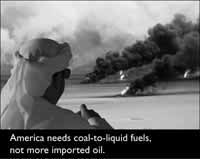Coal-to-Liquids Coalition
|
This article is part of the Coal Issues portal on SourceWatch, a project of Global Energy Monitor and the Center for Media and Democracy. See here for help on adding material to CoalSwarm. |
The Coal-to-Liquids Coalition (CTLC), a U.S.-based front group created by the National Mining Association (NMA), states that its mission is to "articulate policies, educate policy makers and advocate congressional and administrative actions to advance the construction of state-of-the-art coal liquefaction facilities."[1] Coal liquefaction is a term used to a describe a portfolio of technologies that can be used to convert coal (a solid fuel) into more desirable liquid fuels, such as syngas and synfuel. Examples of such coal to liquid technologies include direct hydrogenation and gasification to liquids technologies.
While the coal industry is an obvious beneficiary of the technology, other industries that are heavy users of liquid hydrocarbon fuels are supportive of coal to liquids technologies due to the potential for cheaper liquid fuels should the cost of coal and conversion be less than the cost of liquid fuels made from petroleum.[citation needed]
Contents
The National Mining Association Connection
The CTLC's website domain name -- http://www.futurecoalfuels.org -- was registered on May 5, 2006 by Mike Zabko from the NMA.[2] The domain registration lists the NMA as the registrant, administrative and technical contact for the site. Later that month, the NMA issued a media release announcing it was launching the website as a resource for reporters.[3]
In a profile of the NMA's 2007 lobbying efforts, Ted McKenna from PR Week noted that "the NMA aims to counter the effects of such opprobrium [from environmentalists - ed] through outreach, including direct lobbying of lawmakers; advertising in key DC titles like National Journal and Roll Call; ad and lobbying campaigns by the Coal-to-Liquids Coalition, which is backed by a number of labor unions, in addition to the NMA...". The profile also lists Corey Henry, the Coal-to-Liquids Coalition director of communications, as a member of the NMA's communications team.[4]
Additional Founders
A 2008 story in Politico listed the Air Transport Association, the Association of American Railroads, Sasol, and Syntroeum as founders of CTLC.[5]
CTLC Launch
Wile the NMA had launched its website in May 2006, it wasn't until March 28 the following year that the coalition -- which uses the same website -- was formally launched at in Washington D.C. In a media release announcing the formation of the coalition, Kraig R. Naasz, the president and CEO of the NMA, stated that "It is imperative that this country act boldly and act now to strengthen our ability to serve the country’s energy needs."[6]
The CTLC release also stated that a dozen members of Congress were at the press conference to announce the launch, but did not list all of those in attendance. However, on its website, the CTLC features comments made at the launch by Congressmen Nick Rahall (Democrat-West Virginia) and Senator Jim Bunning (Republican - Kentucky)[7] and a supportive media release by U.S. Congressman Jerry Costello (Democrat-Illinois).[8] (Rahall, along with Geoff Davis (Republican-Kentucky), introduced proposed legislation, H.R. 370 bill known as the Coal-to-Liquids Fuel Promotion Act of 2007).
In his comments at the launch of the coalition, Rahall emphasized that "standing at the forefront of the coal-to-liquids effort is the Air Force. At 93% of total consumption, the Defense Department is the U.S. government's largest user of fuels. And of all four branches at DoD, the Air Force consumes the most, 52%". For his part, Bunning thanked the "National Mining Association and the Coal-to-Liquids Coalition for this event today." He also stated that "while I beleive tax incentives and the military will be the best ways to commercialize coal-to-liquid facilities in the United States, I am open to discussing other options with my colleagues, like price floors and the alternative fuel standard proposed by the President."[7]
Congressional Agenda
On its website the CTLC states that "federal participation in the development of a robust CTL industry is critically important for two reasons. First, financial assistance on a limited scale will help to reassure private investors wary of undertaking major investments in energy technologies untried in the United States. Second, federal participation will discourage the foreign energy cartel from manipulating prices temporarily for the sole purpose of destroying a competing domestic fuel source."[9]
In particular, it states that it would support federal legislation that:
"* Grants the Department of Defense and other federal agencies the ability to enter into long-term, guaranteed fixed price contracts in order to discourage oil exporting countries from manipulating oil prices solely to block U.S. development of CTL fuels;
- Establishes a price collar mechanism to protect domestic CTL producers from foreign energy cartel price manipulation;
- Provides a 20 percent investment tax credit capped at $200 million total per CTL plant placed in service before Dec. 31, 2015;
- Extends the expiration date of the 50 cents per gallon fuel excise tax credit from September 2009 to Dec. 31, 2020 and;
- Allows 100 percent expensing of investments in the year of outlay for any CTL plant online by Dec. 31, 2015."[9]
CTLC's Advertising Campaign
During 2007, the CTLC ran a series of print, online and radio advertisements "in major media outlets in Washington, D.C., and seven states" in an effort to "to educate policymakers, the press and the public" on the benefits of coal-to-liquids fuels.[10] The bulk of the advertisements try to position coal-to-liquids as the key to energy independence and emphasized the need for Congress to support the industry.
One placed in Congress Daily, featured a man holding two dice -- labeled "energy" and "security" -- underneath the headline "America's Energy Security ... relies on more than good luck".[11]
Another in the Pittsburgh Post-Gazette featured the headline "America needs coal-to-liquid fuels, not more imported oil" beneath a large black and white image of a turbaned man looking at a burning oilfield. This advertisement was pointed: "Congress can jumpstart domestic CTL production with reasonable incentives. Or. it can crush CTL with unreasonable requirements."[12]
Another, in the Washington Post, was directly pitched at members of Congress. "American Air Power Needs American Clean Coal Fuels", it stated, with the subtitle that "America's defense requires our biggest energy resource". in the text of the advertisement, the coalition claimed that "The U.S. Air Force wants secure domestic coal-to-liquid fuel ... to end dependency on fuel from some of the world's most dangerous regions ... That's why Congress must give long-term fuel contracting authority to the Department of Defense."[13]
Another specifically took aim at environmental criticisms of the technology by the Natural Resources Defense Council (NRDC). "Coal-to-liquid fuels are clean: Don't be misled by NRDC", the headline of an advertisement placed in Roll Call, a Washington D.C. publication that tracks Capital Hill politics. The advertisement claimed that "clearly, NRDC didn't read the latest report from the Department of Energy's Idaho National Laboratory. CTL fuels are clean".[14]
While the bulk of the advertising budget was spent on inside the Beltway publications, a little was spent on radio advertisements in the major coal states of Montana and North Dakota. The radio advertisements not only touted the coalition's themes of energy and security but encouraged listeners to call specific members of Congress to support the industry. "Montana's Senators Baucas and Tester need to hear from you that America wants coal-to-liquid fuels made from abundant U.S. Coal," the Montana advertisement stated.[15] Across in North Dakota, the coalition ran an identical advertisement, though singling out Senators Kent Conrad and Byron L. Dorgan as the lobbying targets.[16]
To cap their advertising off, the coalition also produced a bumper sticker: "I'm pumped for coal to liquid fuels".
U.S. Air Force abandons CTL plans
Jan. 2009: Air Force cancels Malmstrom Project
On January 20, 2009, the Air Force Times reported that the Air Force had reached a decision on the Malmstrom plant and would announce it on January 16. [17] On January 29, 2009, Air Force officials announced that they had rejected construction proposals and would no longer be pursuing development of the large synthetic fuel plant.[18]
Oct. 2009: Air Force abandons plans to develop CTL plants
On October 21, 2009, the Air Force announced it was no longer pursuing plans to build coal-to-liquids fuel plants as a means of producing alternative jet fuels. Under the Bush administration, the Air Force - which makes up 10 percent of U.S. jet fuel demand - had been pushing to drive the development of a domestic CTL market.[19]
Airlines, however, are looking into synfuel. In December 2009, Rentech announced that several large airline companies including American, US Airways, Delta, and Lufthansa had signed a memorandum of understanding to buy 500,000 barrels per month of jet fuel from the company's proposed synfuel plant, Belwood Coal-to-Liquids. Rentech said that it would capture a portion of the carbon dioxide produced by the plant and pipe it to Texas for enhanced oil recovery. The company also said that the plant is designed to burn biomass as well as coal.[20]
Participants
The CTLC lists its "coalition participants" as being[1]:
- AFL-CIO Building and Construction Trades Department
- AFL-CIO Industrial Union Council
- Air Transport Association
- American Short Line and Regional Railroad Association
- Association of American Railroads
- Baard Energy L.L.C.
- DKRW Advanced Fuels
- GTA Energy
- Headwaters Incorporated
- International Brotherhood of Boilermakers
- International Union of Operating Engineers
- Laborers' International Union of North America
- Owner-Operator Independent Drivers Association
- National Oilheat Research Alliance
- National Mining Association
- Petroleum Marketers Association of America
- Reading Anthracite Company
- Rentech Inc.
- Sasol
- Silverado Green Fuel
- Southern States Energy Board
- Syntroleum Corporation
- Tenaska, Inc.
- United Brotherhood of Carpenters and Joiners of America
- United Mine Workers of America
- WMPI PTY., LLC
Personnel
- Corey Henry, spokesperson
Contact Details
Website: http://www.futurecoalfuels.org
Articles and Resources
Sources
- ↑ 1.0 1.1 Coal-to-Liquids Coalition, 'Mission Statement", Coal-to-Liquids Coalition website, accessed May 2008.
- ↑ FutureCoalFuels.org", Joker.com, accessed May 2008.
- ↑ National Mining Association, "NMA Launches New Web Site on Coal-to-Liquid Fuels", Media Release, May 26, 2006.
- ↑ Ted McKenna, "NMA digs deep to support legislative efforts", PR Week USA, June 25, 2007.
- ↑ Jen Dimascio and Erika Lovley, "Coal lobby benefited from Air Force ally," Politico, 9/18/08
- ↑ "Coal Liquefaction Coalition Working To Boost U.S. Energy Independence", Media Release, March 28, 2007.
- ↑ 7.0 7.1 "Remarks of Nick. J. Rahall, II: Kick Off Of the Coal-To-Liquids Coalition", March 28, 2008.
- ↑ U.S. Congressman Jerry Costello, "Costello: Coal-to-Liquids Coalition Carries Important Message", Media Release, March 28, 2007.
- ↑ 9.0 9.1 Coal-to-Liquids Coalition,"What Congress must do to help", Coal-to-Liquids Coalition website, accessed May 2008.
- ↑ Coal-to-Liquids Coalition, "CTLC Advertisements", Coal-to-Liquids Coalition website, accessed May 2007.
- ↑ Coal-to-Liquids Coalition, "America's Energy Security ... relies on more than good luck", Congress Daily, undated, accessed May 2008.
- ↑ Coal-to-Liquids Coalition, "America needs coal-to-liquid fuels, not more imported oil", Pittsburgh Post-Gazette, undated, accessed May 2008.
- ↑ Coal-to-Liquids Coalition, "American Air Power Needs American Clean Coal Fuels", Washington Post, undated, accessed May 2008.
- ↑ Coal-to-Liquids Coalition, "Coal-to-liquid fuels are clean: Don't be misled by NRDC", Roll Call, undated, accessed May 2008.
- ↑ Coal-to-Liquids Coalition, "Montana advertisement", undated, accessed May 2008.
- ↑ Coal-to-Liquids Coalition, "Montana advertisement", undated, accessed May 2008.
- ↑ "Decision due on Mont. synthetic fuel plant", Air Force Times, January 20, 2009.
- ↑ Peter Johnson, "Officials scrap plans for plant at Malmstrom," Great Falls Tribune, January 30, 2009.
- ↑ "Air Force abandons efforts to spur CTL development," E&ENews PM, October 21, 2009. (Subscription required.)
- ↑ Matthew L. Wald, "Company Aims to Make Jet Fuel from Coal," New York Times, December 15, 2009.



